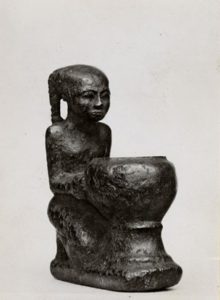Whenever I travel to a new city I always try to visit at least one museum, however the British Museum in London remains my favourite to date, I can easily spend days in there and still find something new and exciting. The British Museum holds a very large and varied collection of ancient Egyptian artefacts, which range from a tiny limestone amulet to huge pieces such as the Rosetta stone and dominating figure heads that would have sat atop statues that were hundreds of metres high. My favourite piece from this collection is an 8.2cm tall cosmetic jar, an item that many ancient Egyptian girls would have had. This particular piece dates back to the New Kingdom (1570-1070BCE) and is in the shape of a basin with a decorative figure of a small girl kneeling to the rear. Cosmetic jars of this type were very common and their decoration meant that they were usually found in burial chambers as well as a vital element of any home.
Cosmetic jars such as this one were made from Steatite, a mineral that is also known as Soapstone. Poorer classes of people would have used wooden jars for everyday use instead, with a hard stone version being placed with their body if they could afford it. Steatite was a very good material for decorative jars and ornaments, as the high talc content made it easy to manipulate and adorn with elaborate carvings and decorations.
The jars were used to contain a variety of items however the most common were eye paint or perfumed oil. Eye paint had been used since the Old Kingdom (2700-2055BCE) although general body paint may have been used for a much longer period. This jar dates from the New Kingdom, which is the period which saw the rise of the use of black galena based kohl rather than the traditional green paint. This lead ore would not just have been used for decoration, but also would have provided the wearer with protection from the sun. There are also several indications that eye makeup held religious significance as green galena eye paint is mentioned in the Pyramid Texts.
Another possible use for this cosmetic jar could have been to store perfumed oil. These oils were made out of vegetable oil or animal fats which were then scented and applied to the hair and skin. The scents were usually made from myrrh, desert date or frankincense. It was a common ancient idea that Egyptian women were famed for having a sweet scent.
Unfortunately as the jar is not on display, it is impossible to identify if there is any black kohl residue in this jar which would have told us which of the two uses this jar would have had.
-Devon Allen
Junior Girl
Girl Museum Inc.


This was fascinating to read.
I’ve never been to the British Museum but having read this article I am planning a visit with my son, we will look out for this cosmetic jar specifically.